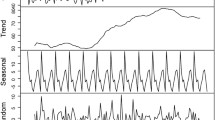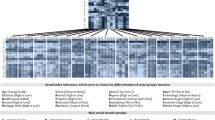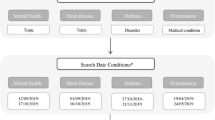Abstract
Internet search engines have become a popular and readily accessible source of information. Google Trends, by means of analyzing the popularity of search queries in Google Search, allows to provide deep insights into population behavior. Interestingly, Google is increasingly being used also to obtain health-related information, as well as to self-prescribe one’s dietary intake. In particular, we analysed the search traffic related to the keywords Mediterranean diet since it has always been very popular. More specifically, we propose to use Google Trends data as proxies for the interest in Mediterranean diet and to analyze them through the functional data analysis (FDA) approach.
Access this chapter
Tax calculation will be finalised at checkout
Purchases are for personal use only
Similar content being viewed by others
References
Aguilera AM, Fortuna F, Escabias M, Di Battista T (2019) Assessing social interest in burnout using Google trends data. Ind Res Soc. https://doi.org/10.1007/s11205-019-02250-5
Bach-Faig A, Berry E, Lairon D, Reguant J, Trichopoulou A, Dernini S, Medina F, Battino M, Belahsen R, Miranda G, Serra-Majem L (2011) Mediterranean diet pyramid today. Science and cultural updates. Public Health Nutr 14(12A):2274–2284. https://doi.org/10.1017/S1368980011002515
Caruso G, Di Battista T, Gattone SA (2019) A micro-level analysis of regional economic activity through a PCA approach. In: Bucciarelli E, Chen S, Corchado JM (eds) Decisions economics: complexity of decisions and decisions for complexity. Advances in intelligent systems and computing (in print)
Caruso G, Gattone SA (2019) Waste management analysis in developing countries through unsupervised classification of mixed data. Soc Sci 8(6)
Caruso G, Gattone SA, Balzanella A, Di Battista T (2019) Cluster analysis: an application to a real mixed-type data set. In: Flaut C, Hoskova-Mayerova S, Flaut D (eds) Models and theories in social systems. Studies in systems, decision and control, vol 179. Springer, pp 525–533
Caruso G, Gattone SA, Fortuna F, Di Battista T (2018) Cluster analysis as a decision-making tool: a methodological review. In: Bucciarelli E, Chen S, Corchado, JM (eds) Decision economics: in the tradition of Herbert A. Simon’s heritage. Advances in intelligent systems and computing, vol 618. Springer, pp 48–55
Choi HY, Varian H (2012) Predicting the present with Google Trends. Econ Rec 88:2–9
D’Adamo I, Falcone PM, Gastaldi M (2019) Price analysis of extra virgin olive oil. Brit Food J. https://doi.org/10.1108/BFJ-03-2019-0186
De Boor C (2001) A practical guide to splines. Springer, New York
Demarin V, Lisak M, Morović S (2011) Mediterranean diet in healthy lifestyle and prevention of stroke. Acta Clin Croat 50(1):67–76
Di Battista T, Fortuna F (2016) Clustering dichotomously scored items through functional k-means algorithm. EJASA 9(2):433–450
Di Battista T, Fortuna F (2017) Functional confidence bands for lichen biodiversity profiles: a case study in Tuscany region (central Italy). Stat Anal Data Min 10(1):21–28
Di Battista T, Gattone SA, De Sanctis A (2010) Dealing with FDA estimation methods. In: Ingrassia S, Rocci R, Vichi M (eds) New perspectives in statistical modeling in data analysis. Advances in intelligent systems and computing. Springer, Cham, pp 357–365
Ferreira L, Hitchcock D (2009) A comparison of hierarchical methods for clustering functional data. Commun Stat-Simul C 38(9):1925–1949
Forgy E (1965) Cluster analysis of multivariate data: efficiency vs interpretability of classifications. Biometrics 21:768–769
Fortuna F, Maturo F, Di Battista T (2018) Clustering functional data streams: unsupervised classification of soccer top players based on Google trends. Qual Reliab Eng Int 34(7):1448–1460
Golley S, Corsini N, Mohr P (2017) Managing symptoms and health through self-prescribed restrictive diets: what can general practitioners learn from the phenomenon of wheat avoidance? Aust Fam Phys 46:603–608
Jain A, Dubes R (1988) Algorithms for clustering data. Prentice Hall, Englewood Cliffs, NY
King R (1971) The “Questione Meridionale” in Southern Italy, vol 11. University of Durham, Department of Geography
Klement R, Frobel T, Albers T, Fikenzer S, Prinzhausen J, Kämmerer U (2013) A pilot case study on the impact of a self-prescribed ketogenic diet on biochemical parameters and running performance in healthy and physically active individuals. Nutr Med 1
Lambert SD, Loiselle CG (2007) Health information-seeking behavior. Qual Health Res 17(8):1006–1019. https://doi.org/10.1177/1049732307305199
MacQueen J (1967) Some methods for classification and analysis of multivariate observations. In: Proceedings of 5th Berkeley symposium on mathematical statistics and probability, 1967. University of California Press
Maturo F, Hoskova-Mayerova S (2016) Fuzzy regression models and alternative operations for economic and social sciences. In: Recent trends in social systems: quantitative theories and quantitative models. Springer, Switzerland, pp 235–247. https://doi.org/10.1007/978-3-319-40585-8_21
Maturo F, Hoskova-Mayerova S (2018) Analyzing research impact via functional data analysis: a powerful tool for scholars, insiders, and research organizations. In: Proceedings of the 31st international business information management association conference innovation management and education excellence through vision 2020, pp 1832–1842. ISBN 978-0-9998551-0-2
McQuitty L (1966) Similarity analysis by reciprocal pairs for discrete and continuous data. Educ Psychol Meas 27:21–46
Nuti SV, Wayda B, Ranasinghe I, Wang S, Dreyer RP, Chen SI et al (2014) The use of Google Trends in health care research: a systematic review. PLoS ONE 9(10):e109583. https://doi.org/10.1371/journal.pone.0109583
Pandey A, Hasan S, Dubey D, Sarangi S (2013) Smartphone apps as a source of cancer information: changing trends in health information-seeking behavior. J Cancer Educ 28(1):138–142
Ramsay JO, Silverman BW (2005) Functional data analysis, 2nd edn. Springer
Sangalli L, Secchi P, Vantini S, Vitelli V (2010) Functional clustering and alignment methods with applications. CAIM 1:205–224
Sangalli L, Secchi P, Vantini S, Vitelli V (2010) K-mean alignment for curve clustering. Comput Stat Data Anal 54:1219–1233
Sneath P (1957) The application of computers to taxonomy. J Gen Microbiol 17:201–226
Sokal R, Michener C (1958) A statistical method for evaluating systematic relationships. Univ Kansas Sci Bull 38:1409–1438
Tan K, Witten D (2015) Statistical properties of convex clustering. Electron J Stat 9:2324–2347
Tarpey T (2007) Linear transformations and the k-means clustering algorithm: applications to clustering curves. J Am Stat Assoc 61(1):34–40
Vance K, Howe W, Dellavalle RP (2009) Social internet sites as a source of public health information. Dermatol Clin 27(2):133–136
Ward J (1963) Hierarchical grouping to optimize an objective function. J Am Stat Assoc 58:236–244
Willett WC, Sacks F, Trichopoulou A, Drescher G, Ferro-Luzzi A, Helsing E, Trichopoulos D (1995) Mediterranean diet pyramid: a cultural model for healthy eating. Am J Clin Nutr 61(6):1402–1406
Author information
Authors and Affiliations
Corresponding author
Editor information
Editors and Affiliations
Rights and permissions
Copyright information
© 2021 The Author(s), under exclusive license to Springer Nature Switzerland AG
About this chapter
Cite this chapter
Caruso, G., Fortuna, F. (2021). Mediterranean Diet Patterns in the Italian Population: A Functional Data Analysis of Google Trends. In: Soitu, D., Hošková-Mayerová, Š., Maturo, F. (eds) Decisions and Trends in Social Systems. Lecture Notes in Networks and Systems, vol 189. Springer, Cham. https://doi.org/10.1007/978-3-030-69094-6_6
Download citation
DOI: https://doi.org/10.1007/978-3-030-69094-6_6
Published:
Publisher Name: Springer, Cham
Print ISBN: 978-3-030-69093-9
Online ISBN: 978-3-030-69094-6
eBook Packages: Intelligent Technologies and RoboticsIntelligent Technologies and Robotics (R0)




